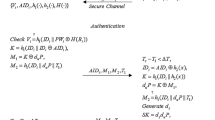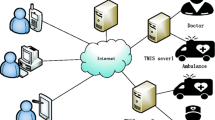Abstract
Significant development of information technologies has made Telecare Medical Information Systems (TMISs) increasingly popular. In a TMIS, patients upload their medical data through smart devices to obtain a doctor’s diagnosis. However, these smart devices have limited computing and storage capacities, so it is difficult to store substantial patient information and to support time-consuming operations. Moreover, although many three-factor authentication protocols have been proposed for TMISs, the problems of privacy leaks and other security flaws are serious. In addition, authentication factors are verified at the user side in most protocols, giving users a high level of trust and resulting in a potential lack of security. In this paper, we propose a novel efficient truly three-factor authentication protocol for TMISs. In our proposed protocol, three factors (i.e., password, smart card and biometrics) are verified at the server side, which reduces the storage and computational burden of the user side. Additionally, our proposed protocol uses only lightweight operators and is thus efficient. A formal proof analysis demonstrates that our proposed protocol is provably secure in the random oracle model. The performance evaluation shows that the proposed protocol is very efficient and suitable for TMISs.

Similar content being viewed by others
References
Amin R, Islam SK, Biswas GP, Khan MK, and Li X, Cryptanalysis and en- hancement of anonymity preserving remote user mutual authentication and session key agreement scheme for e-health care systems. Journal of Medical Systems 2015;39(11):140
An Y, Security analysis and enhancements of an effective biometric-based remote user authentication scheme using smart cards. Journal of Biomedicine & Biotechnology 2012;2012(4):519723
Bresson E, Chevassut O, and Pointcheval D, Security proofs for an efficient password-based key exchange. In: ACM Conference on Computer and Communications Security. 2003. p. 241–50
Chaudhry SA, Naqvi H, and Khan MK, An enhanced lightweight anonymous biometric based authentication scheme for tmis. Multimedia Tools & Applications 2017;(3):1–22
Chaudhry SA, Naqvi H, Shon T, Sher M, and Farash MS, Cryptanalysis and improvement of an improved two factor authentication protocol for telecare medical information systems. Journal of medical systems 2015;39(6):66
Das AK, Analysis and improvement on an efficient biometric-based remote user authentication scheme using smart cards. Information Security Iet 2011;5(3):145–51
Dodis Y, Ostrovsky R, Reyzin L, and Smith A, Fuzzy extractors: How to generate strong keys from biometrics and other noisy data. Siam Journal on Computing 2008;38(1):97–139
Fan CI, and Lin YH, Provably secure remote truly three-factor authentica- tion scheme with privacy protection on biometrics. IEEE Transactions on Information Forensics and Security 2009;4(4):933–45
Hao F, Anderson R, and Daugman J, Combining crypto with biometrics effec- tively. IEEE Transactions on Computers 2006;55(9):1081–8
Jiang Q, Chen Z, Li B, Shen J, Yang L, and Ma J, Security analysis and improvement of bio-hashing based three-factor authentication scheme for telecare medical information systems. Journal of Ambient Intelligence & Humanized Computing 2017;(5): 1–13
Jiang Q, Khan MK, Lu X, Ma J, and He D, A privacy preserving three-factor authentication protocol for e-health clouds. Journal of Supercomputing 2016;72(10):3826–49
Jiang Q, Ma J, Yang C, Ma X, Shen J, and Chaudhry SA, Efficient end-to-end authentication protocol for wearable health monitoring systems . Computers & Electrical Engineering 2017;
Jin Z, Teoh ABJ, Goi BM, and Tay YH, Biometric cryptosystems: A new bio- metric key binding and its implementation for fingerprint minutiae-based representation. Pattern Recognition 2016;56:50–62
Kang H, Hori Y, Katashita T, Hagiwara M, and Iwamura K, Cryptographie key generation from puf data using efficient fuzzy extractors. In: International Conference on Advanced Communication Technology. 2014. p. 23–6
Kelkboom EJC, Breebaart J, Buhan I, and Veldhuis RNJ, Maximum key size and classification performance of fuzzy commitment for gaussian modeled biometric sources. IEEE Transactions on Information Forensics & Security 2012;7(4):1225–41
Khan MK, and Kumari S, An improved biometrics-based remote user authentication scheme with user anonymity. BioMed research international 2013;2013(5):491289
Li CT, and Hwang MS, An efficient biometrics-based remote user authentica- tion scheme using smart cards. Academic Press Ltd., 2010
Li X, Niu JW, Ma J, Wang WD, and Liu CL, Cryptanalysis and improvement of a biometrics-based remote user authentication scheme using smart cards. Journal of Network & Computer Applications 2011;34(1):73–9
Li X, Wen Q, Li W, Zhang H, and Jin Z, Secure privacy-preserving biometric authentication scheme for telecare medicine information systems. Journal of Medical Systems 2014;38(11):139
Li X, Wu F, Khan MK, Xu L, Shen J, and Jo M, A secure chaotic map-based remote authentication scheme for telecare medicine information systems. Future Generation Computer Systems 2017
Mir O, and Nikooghadam M, A secure biometrics based authentication with key agreement scheme in telemedicine networks for e-health services. Wireless Personal Communications 2015;83(4):2439–61
Nandakumar K, Jain AK, and Pankanti S, Fingerprint-based fuzzy vault: Implementation and performance. IEEE Transactions on Information Forensics & Security 2007;2(4):744–57
Vallent TF, and Kim H, Three Factor Authentication Protocol Based on Bilin- ear Pairing. Springer Netherlands, 2013
Wang D, and Wang P: Understanding security failures of two-factor authentication schemes for real-time applications in hierarchical wireless sensor networks. Ad Hoc Networks 2014;20(2):1–15
Wazid M, Das AK, Kumari S, Li X, and Wu F, Design of an efficient and provably secure anonymity preserving threefactor user authentication and key agreement scheme for tmis. Security & Communication Networks 2016;9(13):1983–2001
Wu F, Xu L, Kumari S, and Li X, A novel and provably secure biometrics-based three-factor remote authentication scheme for mobile clientserver networks . Computers & Electrical Engineering 2015;45(C):274–85
Wu ZY, Lee YC, Lai F, Lee HC, and Chung Y, A secure authentication scheme for telecare medicine information systems. Journal of medical systems 2012;36(3):1529–35
Xie Q, Wong D, Wang G, Tan X, Chen K, and Fang L, Provably secure dynamic id-based anonymous two-factor authenticated key exchange protocol with extended security model. IEEE Transactions on Information Forensics & Security 2017;12(6):1382–92
Xiong H, Tao J, and Yuan C, Enabling telecare medical information systems with strong authentication and anonymity. IEEE Access 2017;5:5648–61
Xu L, and Wu F, Cryptanalysis and improvement of a user authentication scheme preserving uniqueness and anonymity for connected health care. J Med Syst 2015;39(2):10
Yeh HL, Chen TH, Hu KJ, and Shih WK, Robust elliptic curve cryptography- based three factor user authentication providing privacy of biometric data. Iet Information Security 2013;7(3):247–52
Zhang L, Zhang Y, Tang S, and Luo H, Privacy protection for e-health systems by means of dynamic authentication and three-factor key agreement. IEEE Transactions on Industrial Electronics ;PP(99):1–
Zhang L, Zhu S, and Tang S, Privacy protection for telecare medicine in- formation systems using a chaotic map-based three-factor authenticated key agreement scheme. IEEE Journal of Biomedical & Health Informatics 2017;PP(99):1–
Acknowledgements
The work was supported by the National Natural Science Foundation of China under Grant 61572370, 61501333 and 61572379.
Author information
Authors and Affiliations
Corresponding author
Additional information
This article is part of the Topical Collection on Systems-Level Quality Improvement
Rights and permissions
About this article
Cite this article
Xu, D., Chen, J., Zhang, S. et al. Privacy-Preserving and Efficient Truly Three-Factor Authentication Scheme for Telecare Medical Information Systems. J Med Syst 42, 219 (2018). https://doi.org/10.1007/s10916-018-1047-x
Received:
Accepted:
Published:
DOI: https://doi.org/10.1007/s10916-018-1047-x




